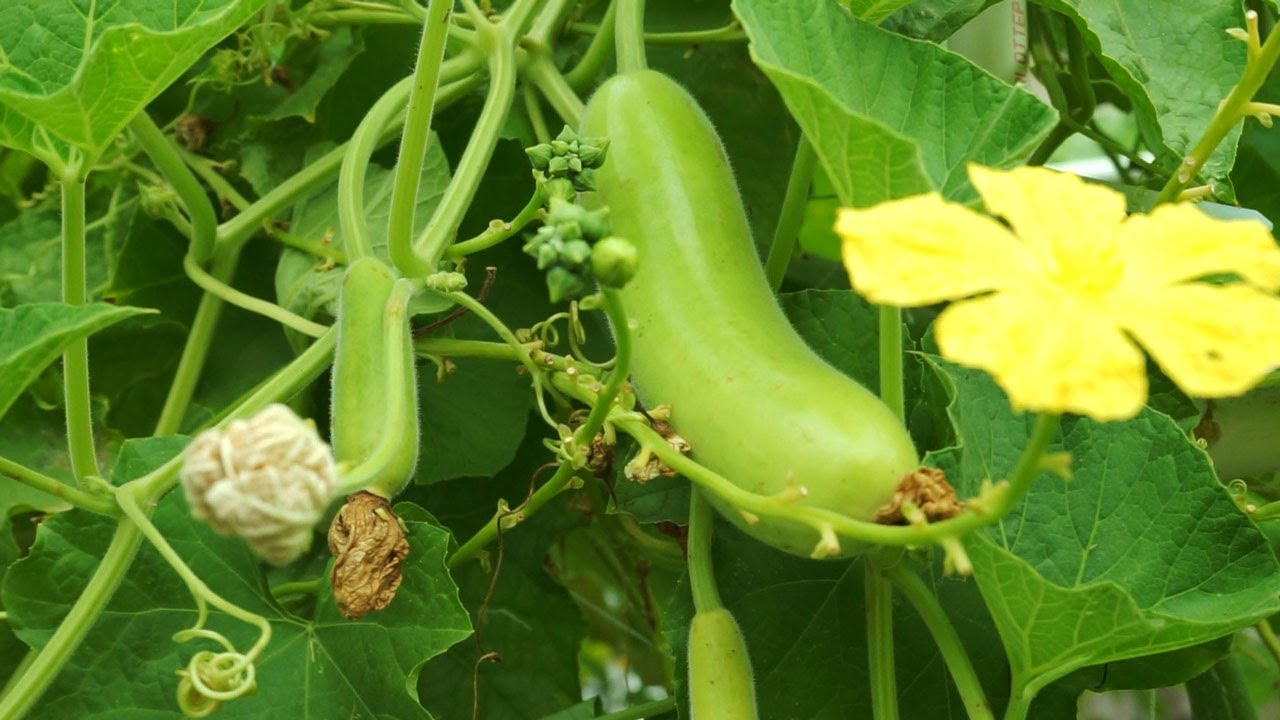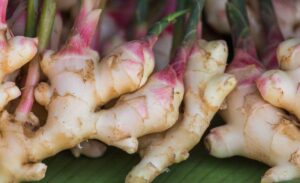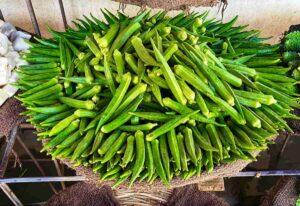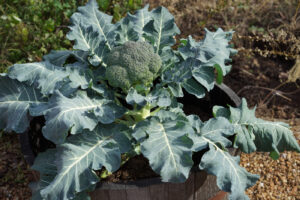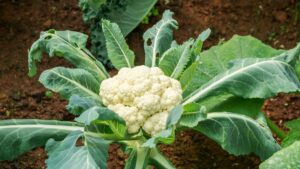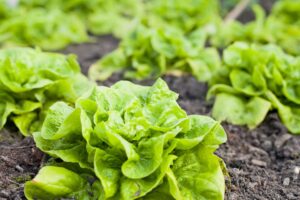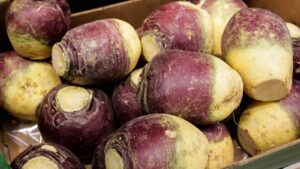How to Grow and Use Bottle Gourd: A Complete Guide
Are you looking to add an impressive and versatile vegetable to your home garden? Bottle gourd (Lagenaria siceraria), also known as calabash, may be the perfect choice for your gardening adventure. With its distinctive elongated shape and numerous culinary applications, this member of the cucurbit family has been cultivated for thousands of years across various cultures. In this comprehensive guide, you’ll discover everything you need to know about growing bottle gourd in your home, garden pots, or even indoors—all from simple seeds.
What is Bottle Gourd?
Bottle gourd is a warm-season vine crop native to Africa that has spread globally due to its versatility. Its name comes from the distinctive bottle-like shape of its fruit, which can grow to impressive sizes. In the United States, bottle gourd has gained popularity both as an ornamental plant and a nutritious vegetable. According to the USDA Agricultural Research Service, bottle gourd is considered one of the oldest cultivated plants, with archaeological evidence suggesting its cultivation dating back over 10,000 years.
Benefits of Growing Bottle Gourd
Before diving into the growing process, let’s explore why bottle gourd deserves a place in your garden:
- Nutritional Value: Bottle gourd is low in calories and fat but rich in vitamins A, C, and K, along with essential minerals.
- Culinary Versatility: The tender young fruits can be used in soups, stews, curries, and stir-fries.
- Medicinal Properties: In traditional medicine, bottle gourd has been used to address digestive issues and reduce inflammation.
- Space Efficiency: When grown vertically on trellises, bottle gourds can thrive even in limited garden spaces.
- Economic Value: With growing interest in diverse vegetables in the US market, home-grown bottle gourds can be sold at local farmers’ markets.
Growing Conditions for Bottle Gourd
Bottle gourd thrives under specific conditions, and understanding these requirements will set you up for successful cultivation:
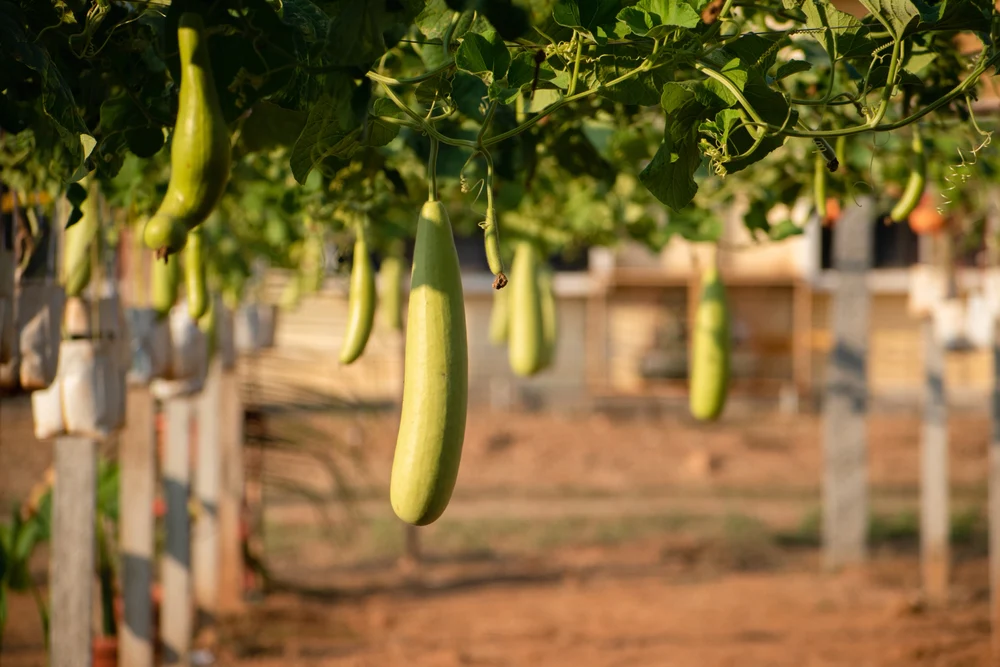
Climate Requirements
Bottle gourd is a tropical plant that requires:
- Warm temperatures between 75-85°F (24-29°C)
- Full sun exposure (at least 6-8 hours daily)
- Growing season of 120-150 days without frost
- Humidity levels between 50-70%
According to the National Center for Home Food Preservation, in most parts of the United States, bottle gourd is best planted after all danger of frost has passed, typically between April and June, depending on your USDA hardiness zone.
Soil Requirements
To ensure healthy growth of your bottle gourd plants:
- Use well-draining, fertile soil with a pH between 6.0-6.8
- Incorporate plenty of organic matter like compost or well-rotted manure
- Ensure soil temperature is at least 65°F (18°C) before planting
How to Grow Bottle Gourd from Seeds
Seed Selection and Preparation
Your bottle gourd growing journey begins with quality seeds:
- Source Quality Seeds: Purchase seeds from reputable suppliers or save seeds from mature bottle gourds from a previous harvest.
- Seed Viability Test: Place seeds in water—those that sink are viable, while floating seeds should be discarded.
- Seed Treatment: To improve germination rates, soak seeds in warm water for 24 hours before planting.
- Scarification: Gently nick or file the hard seed coat to improve water absorption and germination rates.
Direct Sowing Outdoors
If you’re planting directly in your garden:
- Wait until soil temperatures reach at least 65°F (18°C).
- Prepare raised mounds spaced 6-8 feet apart.
- Plant 2-3 seeds per mound at a depth of 1 inch.
- Water thoroughly but gently after planting.
- Thin to the strongest seedling once plants reach 3-4 inches in height.
Starting Seeds Indoors
For an earlier start, especially in cooler climates:
- Start seeds 3-4 weeks before the last expected frost.
- Use biodegradable pots (3-4 inches) filled with seed starting mix.
- Plant seeds 1 inch deep, one seed per pot.
- Maintain soil temperature between 75-85°F (24-29°C) using a heat mat if necessary.
- Place in a location with bright, indirect light.
- Once seedlings develop 2-3 true leaves, harden them off for a week before transplanting outdoors.
Growing Bottle Gourd in Different Settings
Growing in Garden Beds
For traditional garden cultivation:
- Space Planning: Allow 25-30 square feet per plant when growing on the ground, or 10-15 square feet when using trellises.
- Support Structures: Install sturdy trellises, fences, or arbors for the vines to climb.
- Mulching: Apply a 2-3 inch layer of organic mulch to conserve moisture and suppress weeds.
- Companion Planting: Plant alongside corn, beans, or nasturtiums, but avoid growing with potatoes or other cucurbits.
Growing in Containers
Yes, you can grow bottle gourd in containers! Here’s how:
- Container Selection: Choose containers at least 24 inches in diameter and 12 inches deep with adequate drainage holes.
- Growing Medium: Use a mix of potting soil, compost, and perlite for proper drainage.
- Support: Provide a trellis or support system that can bear the weight of developing fruits.
- Spacing: Limit to one plant per large container.
- Watering: Container plants may need more frequent watering than garden-grown plants.
Growing Indoors
For indoor cultivation during colder months:
- Location: Select a sunny south-facing window or use grow lights providing 14-16 hours of light daily.
- Temperature Control: Maintain temperatures between 70-80°F (21-27°C) during the day and not below 65°F (18°C) at night.
- Pollination: Hand-pollinate flowers since natural pollinators won’t be present indoors.
- Air Circulation: Use a small fan to improve air circulation and prevent fungal diseases.
Bottle Gourd Care Guide
Watering Requirements
Proper watering is crucial for bottle gourd development:
- Water deeply 1-2 times per week, providing about 1-1.5 inches of water each time.
- Use drip irrigation or soaker hoses to keep foliage dry and prevent disease.
- Reduce watering once fruits begin to mature to improve flavor and storage quality.
Fertilization Schedule
Follow this fertilization timeline for optimal results:
| Growth Stage | Fertilizer Type | Application Rate | Frequency |
|---|---|---|---|
| Pre-planting | Compost/Manure | 2-3 inches worked into soil | Once |
| Seedling (2-3 weeks) | Balanced (10-10-10) | Half strength | Every 2 weeks |
| Vegetative Growth | Nitrogen-rich (15-5-5) | As directed on package | Every 3 weeks |
| Flowering & Fruiting | Phosphorus-rich (5-10-10) | As directed on package | Every 3-4 weeks |
| Late Season | Potassium-rich (5-5-15) | Half strength | Once |
Pruning and Training
Proper pruning maximizes yield and plant health:
- Main Vine Management: Allow the main vine to grow to 10-12 feet before pinching the growing tip.
- Side Shoot Control: Limit side shoots to 4-5 per plant, removing excess growth.
- Fruit Selection: For larger bottle gourds, limit to 3-4 fruits per vine.
- Training Techniques: Gently guide vines along support structures using soft plant ties.
Common Pests and Diseases
Watch for these common issues and their solutions:
Pests:
- Squash Vine Borers: Protect stem bases with aluminum foil and inspect regularly for entry holes.
- Cucumber Beetles: Use floating row covers until flowering and introduce beneficial insects.
- Aphids: Spray with strong water jets or insecticidal soap solutions.
Diseases:
- Powdery Mildew: Improve air circulation and apply neem oil or potassium bicarbonate sprays.
- Downy Mildew: Avoid overhead watering and use copper-based fungicides if necessary.
- Bacterial Wilt: Remove and destroy infected plants and control cucumber beetles that spread the disease.
Harvesting and Storing Bottle Gourd
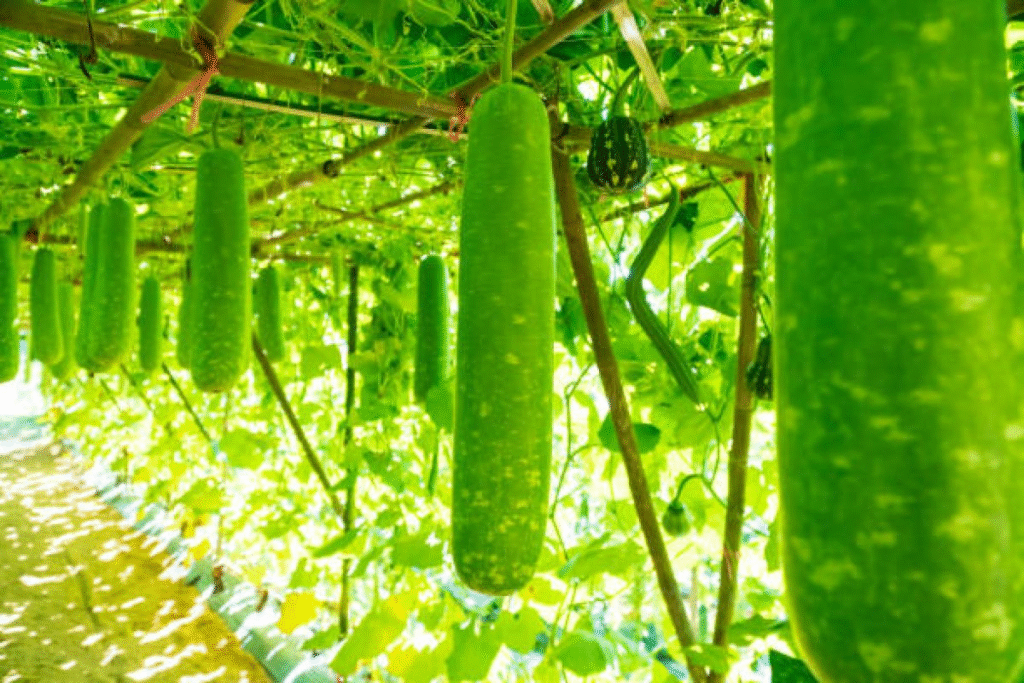
When to Harvest
The timing of your harvest depends on your intended use:
- For tender vegetables: Harvest when fruits are 8-12 inches long, about 10-15 days after flowering.
- For mature gourds (craft purposes): Allow to fully mature on the vine until the stem dries and browns.
Harvesting Technique
Follow these steps for proper harvesting:
- Use sharp, clean pruning shears or a knife to cut the stem 1-2 inches above the fruit.
- Handle gourds carefully to avoid bruising or scratching.
- Harvest in the morning when temperatures are cooler.
- For seed saving, allow selected fruits to fully mature on the vine.
Storage Methods
Proper storage extends the shelf life of your bottle gourds:
- Young Gourds (Culinary Use): Store in the refrigerator’s crisper drawer for up to 1 week.
- Mature Gourds: Cure in a warm, dry, well-ventilated area for two weeks, then store in a cool, dry place for several months.
Culinary Uses of Bottle Gourd
Bottle gourd is incredibly versatile in the kitchen:
Preparation Methods
- Peeling: Young gourds don’t require peeling, while mature ones should have their tougher skin removed.
- Seeding: Remove seeds from the central cavity before cooking.
- Cutting: Can be diced, sliced, or julienned depending on your recipe.
Popular Recipes
- Bottle Gourd Soup: A light, nutritious starter with ginger and garlic.
- Stuffed Bottle Gourd: Hollowed and filled with spiced mixtures of meat or vegetables.
- Bottle Gourd Curry: Simmered with spices and served with rice or flatbreads.
- Bottle Gourd Bread: Incorporating grated gourd into quick bread recipes for added moisture.
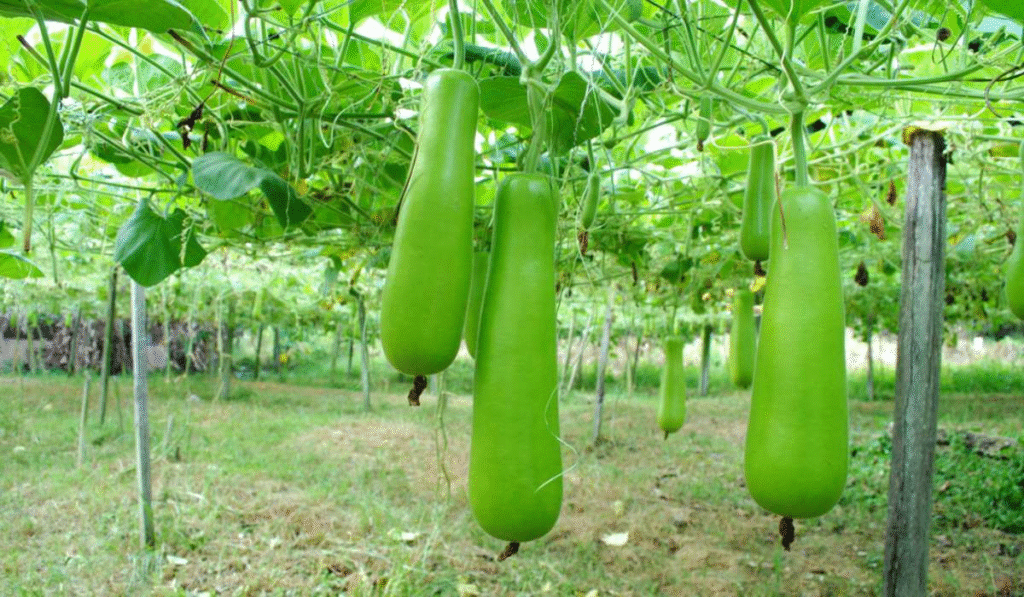
US Market Potential for Bottle Gourd
The bottle gourd market in the United States shows promising growth potential:
Current Market Status
- Increasing demand in areas with diverse ethnic populations
- Growing interest in specialty and heirloom vegetables
- Premium pricing compared to conventional vegetables
Marketing Opportunities
- Local farmers’ markets and CSA programs
- Specialty grocery stores and ethnic markets
- Restaurant supply for farm-to-table establishments
- Value-added products like dried gourd crafts
According to the USDA Economics, Statistics and Market Information System, specialty crop markets have seen steady growth, with consumers increasingly willing to pay premium prices for unique, locally grown produce like bottle gourd.
Sustainability and Environmental Benefits
Growing bottle gourd contributes to sustainable gardening practices:
- Water Conservation: Deep root systems help improve soil structure and water retention.
- Biodiversity: Flowers attract beneficial pollinators to your garden.
- Food Security: Provides nutritious food with minimal resource input.
- Carbon Footprint: Home-grown produce reduces transportation emissions.
Conclusion
Growing bottle gourd offers multiple rewards—from the satisfaction of cultivating an ancient crop to enjoying its culinary versatility. Whether you’re planting in a spacious garden, a modest container on your patio, or even indoors under grow lights, bottle gourd can thrive with proper care and attention to its needs.
By following the guidance in this article, you’ll be well-equipped to grow healthy, productive bottle gourd plants and enjoy their bounty. As interest in diverse vegetables continues to grow in the US market, your bottle gourd cultivation skills might even develop into a profitable hobby or small business venture.
Ready to get started? With the right timing, conditions, and care, you’ll soon be harvesting your own impressive bottle gourds and discovering the many ways to incorporate them into your cooking and lifestyle.
